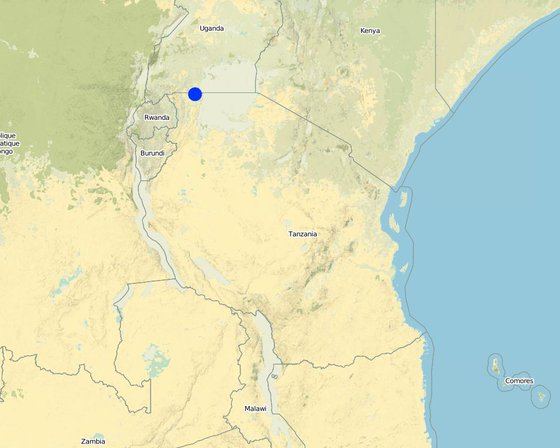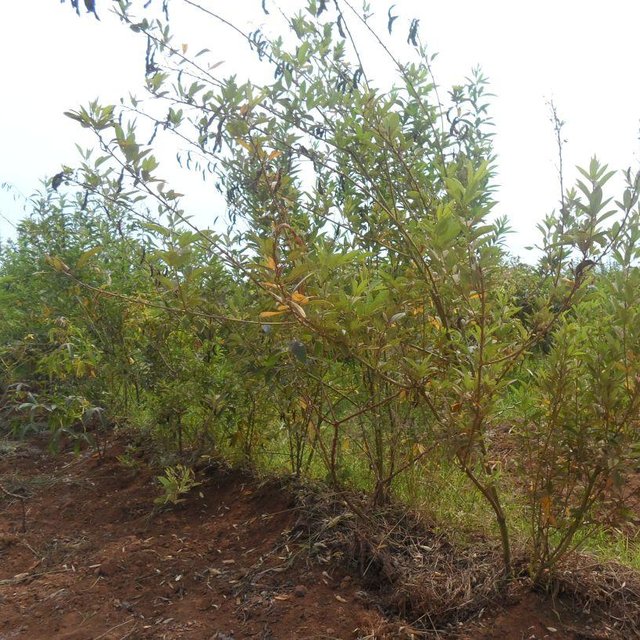

The technology involves a combination of structural, vegetative and agronomic land use practices aiming at improving production of cassava (Manihot esculenta), improving potential of the soil and environmental function of the land. The technology is among a list of basket of choices of SLM practices recently introduced and adapted to the area by land user and experts working with SCC-Vi Agroforestry an NGO contracted/outsourced by the Tras-boundary Agro-ecosystem Management Project (Kagera TAMP) for provision of SLM advisory and extension services.
Contour bunds are constructed across the sloppy landscapes of average slope 5 – 8 % and are arranged in rows from the top to the bottom of the slope. The average distance between contour bunds is 15 meters. A contour bund is a row of long narrow furrow of average width 90cm and average depth 30cm dug across the slope using simple tools and leveled using A-frame method. Dug soils are piled below the slope to form a long strip earth of fanya chini bund. The average height and width of a bund is 30cm and 45cm respectively. Pigeon pea (Cajanus cajan) are planted on contour bund to make them more stronger and productive. A single stand of pigeon pea has two plants and the distance between stands is 30 cm. Improved cassavas (Manihot esculenta) variety (mkombozi) that are resistant to cassava mosaic virus are planted in rows between contour bunds. Within rows, the space between cassavas is 1meter and between rows is 1meter. Manure application is applied before cassava planting at the rate of 2kgs per each plant hole. Cassava is usually planted on May and is harvested after one year. Cassava is planted together with groundnuts (Arachis hypogea) as a cover crop. Despite of having the nutritional advantage to farmers, pigeon pea and groundnuts also diversifies farmers’ livelihood income and have a key role of improving ecosystem through soil water conservation (prevent unproductive loss of green water) and improve soil fertility (through soil nutrient replenishment) and their after harvest remains are sources of organic matter.
Purpose of the Technology: The purpose of the technology is to:
1) Increase cassava productivity 2) Improved livelihood of the rural poor through diversification of income sources (cajanus cajan, groundnuts and cassava) and 3) conserve and restore ecosystem through soil fertility improvement (replacement of nutrients lost through uptake by plants), soil moisture improvement (by preventing blue water loss through runoff and green water loss through unproductive evaporation) and control of cassava pests and diseases (use of cassava varieties that are resistant to cassava mosaic virus).
Establishment / maintenance activities and inputs: Establishment activities include land preparation, ploughing and harrowing, contour bund construction and leveling using A-frame, manure procurement and application. Maintenance and recurrent activities involves collection of cassava planting materials and planting, vegetative stabilization of the bunds by planting Cajanus cajan, planting of cover crops (groundnuts within cassava farm), weeding/gap filling and harvesting.
Natural / human environment: The natural environment includes crop land dominated with separate annual crops. A combination of structural and vegetative measure (contour bund strengthened and made more productive with Cajanus cajan). Climatic zone is sub humid with 210 length of growing period (LGP). Slope category is moderate lying between 5-8%. Soil texture is gravel sandy loam with medium soil depth.
On human environment, mechanization is dominated by use of handy tools and occasional use of tractors. Production system is mixed (both for subsistence and commercial purposes). Inputs used includes tools (hand hoe, machete, sickles, spade and mattock), light and heavy labour, manure, seeds and cassava planting materials with average annual costs of 1033.47 USD per hectare. Land ownership is individual not titles. The expected average annual gross revenue per hectare accrued from cassava alone is 20580 USD.

สถานที่: Missenyi District Council/Minziro village, Tanzania/Kagera region, แทนซาเนีย
ตำนวนการวิเคราะห์เทคโนโลยี:
การเผยแพร่ของเทคโนโลยี: กระจายไปอย่างสม่ำเสมอในพื้นที่ (approx. < 0.1 ตร.กม.(10 เฮกตาร์))
In a permanently protected area?:
วันที่ในการดำเนินการ: น้อยกว่า 10 ปี (ไม่นานนี้)
ประเภทของการแนะนำ






| ปัจจัยนำเข้า | หน่วย | ปริมาณ | ค่าใช้จ่ายต่อหน่วย (Tanzanian shillings) | ค่าใช้จ่ายทั้งหมดต่อปัจจัยนำเข้า (Tanzanian shillings) | %ของค่าใช้จ่ายที่ก่อให้เกิดขึ้นโดยผู้ใช้ที่ดิน |
| แรงงาน | |||||
| Planting cajanus cajan (perennial shrub) | person/days | 13.0 | 1.7 | 22.1 | 100.0 |
| Construction of contour bunds | person/days | 13.0 | 3.46 | 44.98 | 100.0 |
| อุปกรณ์ | |||||
| Tractor (hired) | pieces | 1.0 | 95.0 | 95.0 | |
| Tools | pieces | 34.0 | 2.941 | 99.99 | 100.0 |
| วัสดุด้านพืช | |||||
| Seeds | kg | 6.0 | 27.0 | 162.0 | |
| ค่าใช้จ่ายทั้งหมดของการจัดตั้งเทคโนโลยี | 424.07 | ||||
| Total costs for establishment of the Technology in USD | 0.25 | ||||
| ปัจจัยนำเข้า | หน่วย | ปริมาณ | ค่าใช้จ่ายต่อหน่วย (Tanzanian shillings) | ค่าใช้จ่ายทั้งหมดต่อปัจจัยนำเข้า (Tanzanian shillings) | %ของค่าใช้จ่ายที่ก่อให้เกิดขึ้นโดยผู้ใช้ที่ดิน |
| แรงงาน | |||||
| land preparation for tractor operation/ cleaning/grass slashing (usually occasional depends on land complexity) | person/days | 13.0 | 1.7615 | 22.9 | 100.0 |
| land manual harrowing (after tractor tilling). | person/days | 13.0 | 3.55 | 46.15 | 100.0 |
| manure application | person/days | 13.0 | 3.55 | 46.15 | 100.0 |
| Planting of cassava and groundnuts. | person/days | 13.0 | 0.88 | 11.44 | |
| วัสดุด้านพืช | |||||
| Groudnut seeds | kg | 200.0 | 0.4706 | 94.12 | 100.0 |
| Cassava cuttings | cuttings | 10000.0 | 0.011765 | 117.65 | |
| ปุ๋ยและสารฆ่า/ยับยั้งการเจริญเติบโตของสิ่งมีชีวิต (ไบโอไซด์) | |||||
| Compost/manure | tons/ha | 10.0 | 13.235 | 132.35 | |
| อื่น ๆ | |||||
| Labour: weeding cassava, groundnuts and pigeon pea (done concurrently) | person/days | 13.0 | 3.54 | 46.02 | 100.0 |
| Labour: Harvesting and transportation of groundnuts. | person/days | 13.0 | 0.88 | 11.44 | 100.0 |
| Harvesting and transportation of cassava (after one year) | person/days | 13.0 | 2.65 | 34.45 | 100.0 |
| Labour: harvesting cajanus cajan | person/days | 13.0 | 1.76 | 22.88 | 100.0 |
| Labour: Maintenance of the contour bunds (cleaning of the furrow floor/walls and reshaping of the bunds) | person/days | 6.0 | 3.83333 | 23.0 | 100.0 |
| ค่าใช้จ่ายทั้งหมดของการบำรุงรักษาสภาพเทคโนโลยี | 608.55 | ||||
| Total costs for maintenance of the Technology in USD | 0.36 | ||||
จำนวนก่อน SLM: 1-2 kgs of cassava per crop stand
หลังจาก SLM: 2.5-4 Kgs of cassava per crop stand
due to manure application.
จำนวนก่อน SLM: 50% risk
หลังจาก SLM: 10-20% risk
due controll of soil erosion, soil fertility improvement and cantroll of moisture stress.
จำนวนก่อน SLM: 0 tons/ha
หลังจาก SLM: 20 tons/ha
Use of farm yard manure.
จำนวนก่อน SLM: 1 income source (cassava)
หลังจาก SLM: 3 more sources.
additional income from cajanus cajan, groundnuts and beans
จำนวนก่อน SLM: 6
หลังจาก SLM: 12
the technology is labour intensive and heavy labour is needed
จำนวนก่อน SLM: 1
หลังจาก SLM: 3
incresed no of diets cajanus cajan and beans/protein, cassava/carbohydretes, groundnuts/oil
จำนวนก่อน SLM: 10%
หลังจาก SLM: 33%
access to varied food sources and capacity to invest in health services.
จำนวนก่อน SLM: 0
หลังจาก SLM: 1
FFS SLM groups
จำนวนก่อน SLM: 5%
หลังจาก SLM: 20%
% land users aware of improved conservation/erosion knowledge
จำนวนก่อน SLM: 5%
หลังจาก SLM: 40%
women involvement in SLM activities
the technology resulted in increased crop production emanated from improved soil fertility and control of erosion. There is also diversification of income sources from cover crops (groundnuts) and cajanus cajan (cow pea) as well as improved diet due to varied food sources. All these contributed to improved livelihood and human well-being
จำนวนก่อน SLM: 30%
หลังจาก SLM: 5%
runoff speed reduced through the use of contour bund and cover crops
จำนวนก่อน SLM: 20%
หลังจาก SLM: 10%
evaporation reduced from use of civer crops.
จำนวนก่อน SLM: 10%
หลังจาก SLM: 20%
water stored in soil due to the use of contour bunds and cover crops
จำนวนก่อน SLM: 10%
หลังจาก SLM: 45%
increased percentage monthly soil coverage with cover crops (ground nuts and beans)
จำนวนก่อน SLM: low
หลังจาก SLM: high
nutrients generated from the use of beans (phaseola vulgaris)
จำนวนก่อน SLM: low
หลังจาก SLM: high
following use of farm yard manure
จำนวนก่อน SLM: 1
หลังจาก SLM: 3
crop varieties planted in different phases on the same land
จำนวนก่อน SLM: low
หลังจาก SLM: high
Farm yard manure is a good medium for increased microbial action and soil fauna
จำนวนก่อน SLM: 0%
หลังจาก SLM: 50%
increased possibilities for using pest and disease resistant varieties.
จำนวนก่อน SLM: 0%
หลังจาก SLM: 100%
Area put uder cultivation are usually protected and less prone to fire burning
จำนวนก่อน SLM: low
หลังจาก SLM: high
indirect reduced water loos due to runoff
จำนวนก่อน SLM: low
หลังจาก SLM: high
rainfall runoff impeded or trapped by contour bunds
จำนวนก่อน SLM: low
หลังจาก SLM: high
reduced siltation of the natural water spring in the lower mountain/hilly floors.
จำนวนก่อน SLM: low
หลังจาก SLM: high
reduced distruction of public roads through eroded soil.